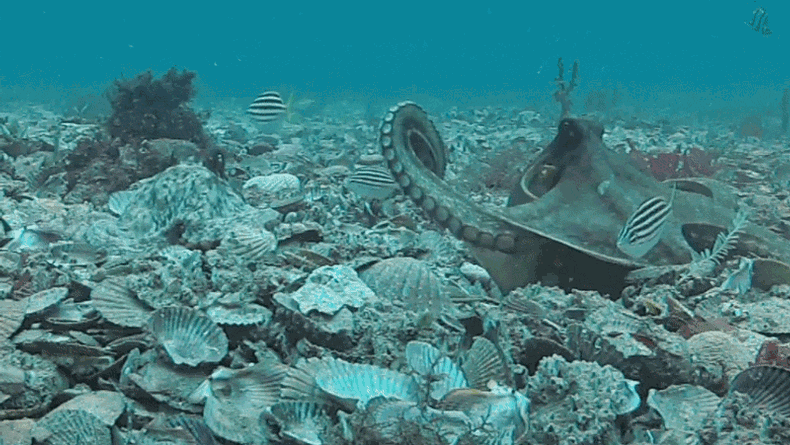6 Weird and Wild Animal Behaviors Revealed in 2022 – Scientific American
Knowledge within reach
Octopus outbursts, spiders evading sexual cannibalism and a human-cockatoo arms race—here are strange animal behaviors we learned about in 2022
The diverse animals that dwell on Earth have adapted to survive in their environments and interact with members of their and other species in ways that can be exquisitely fine-tuned—and sometimes downright weird. Every year researchers turn up new findings on the strange, cool and sometimes hilarious behaviors animals can exhibit, and 2022 was certainly no exception. Below Scientific American has rounded up a few of our favorites from the past year.
Like a New Yorker declaring, “Hey, I’m walkin’ here!” gloomy octopuses living in dense conditions off the coast of Australia might communicate with their fellows—by throwing things. Underwater cameras captured the cephalopods collecting shells, silt and algae with their arms and hurling them at one another by using jets of water from their siphon to propel the scraps. The researchers even observed the receiving octopuses ducking to avoid a hit. Scientists haven’t yet worked out exactly what motivates the behavior but suspect it is some form of communication.
Life can be tough for some male spiders looking to reproduce because it can end with them being eaten by their mate in a practice called sexual cannibalism. But the males of a species of orb-weaving spiders have figured out how to avoid this grisly end: energy stored in their front legs lets them catapult off a hungry female in a split second. “Imagine a man with a height of 1.8 meters catapulting himself 530 meters in one second,” the study’s lead author Shichang Zhang, a behavioral ecologist at China’s Hubei University, told Scientific American. “That’s what these male spiders do.” And they live to mate another day.
Researchers got a big surprise when their underwater cameras showed colonies of fuzzy deep-sea sponges carpeting extinct volcanoes in the extreme conditions at the bottom of the frigid, ice-covered Arctic Ocean. How were these creatures surviving in an area notoriously thin on food? It turns out they have bacteria that help them digest the fossils of long-extinct tube worms.
Little kids aren’t the only ones who pick their nose and eat what they dig up. An aye-aye—a type of lemur—was spotted on camera “digging for gold.” And it did so with its three-inch-long middle finger, typically used in the animals’ nocturnal hunts for insects in logs. When inserted in an aye-aye’s nose, the finger can reach all the way to its throat! As for why aye-ayes practice extreme nose picking, scientists aren’t sure, suggesting perhaps they do it because they can.
Okay, so technically these aren’t animals. But they are living organisms, and they bring plenty of weird to the table. Mixoplankton are protists, which are basically any eukaryote—an organism with one or more cells that have a nucleus and organelles—that isn’t an animal, plant or fungus. They get energy through both photosynthesis and eating other microbes. This year scientists discovered one species of mixoplankton, Prorocentrum cf. balticum, builds a bubble of mucus around its body overnight and then lures its prey (microbes) into this “mucosphere.” That mucosphere is also rich in carbon, which is stored on the seafloor after the mucus is shed.
An innovation arms race may be raging between cockatoos and humans in the suburbs of Sydney, Australia. The highly intelligent birds have worked out ways to use their beak and feet to open residential garbage bins. Tired of the resulting trash-strewn streets, residents have tried to devise ways to keep the birds out, such as placing heavy rocks on the lids. The birds have since learned to defeat at least one of these strategies, suggesting they may learn and adapt, forcing humans to look for more elaborate methods to ward them off. We, for one, welcome our bin-raiding avian overlords.
Video Credit: Barbara Klump/Current Biology (CC BY-SA 4.0)
Andrea Thompson, an associate editor at Scientific American, covers sustainability. Follow Andrea Thompson on Twitter
Chelsea Harvey, Sara Schonhardt and E&E News
Thomas Talhelm | Opinion
Jason Drakeford, Clara Moskowitz and Jeffery DelViscio
Piers Vitebsky
Timmy Broderick
Phil Plait | Opinion
Discover world-changing science. Explore our digital archive back to 1845, including articles by more than 150 Nobel Prize winners.
Follow us
Scientific american arabic
© 2023 Scientific American, a Division of Springer Nature America, Inc.
All Rights Reserved.
Support science journalism.
Thanks for reading Scientific American. Knowledge awaits.
Already a subscriber? Sign in.
Thanks for reading Scientific American. Create your free account or Sign in to continue.
See Subscription Options
Continue reading with a Scientific American subscription.
You may cancel at any time.



